Mary Pat Kelly writes about her friendship with politician and peacemaker, John Hume
“Mr. Hume says Northern Ireland is too complicated to reduce to a Yes/No proposition,” Ted Smyth said to me. Fall 1976. I’m an Associate Producer at Good Morning America and Ted’s the Press Secretary for the Irish Embassy. We didn’t realize how young we were – Ted wasn’t 30; I was 31 and John Hume hadn’t turned 40.
“But,” I said, “this would be his chance to reach millions of Americans who have never heard of him. Tell him we just beat the Today Show in ratings.”
Ted had pitched John Hume to me as the leader of the Martin Luther King-inspired Civil Rights Movement in Northern Ireland — the voice of Irish constitutional nationalism. Like most Irish Americans I was sympathetic to the Catholics of the North, had been horrified by Bloody Sunday, and hoped for a united Ireland but hesitated to support the violence of an armed struggle. Here was an alternative.
I was sold.
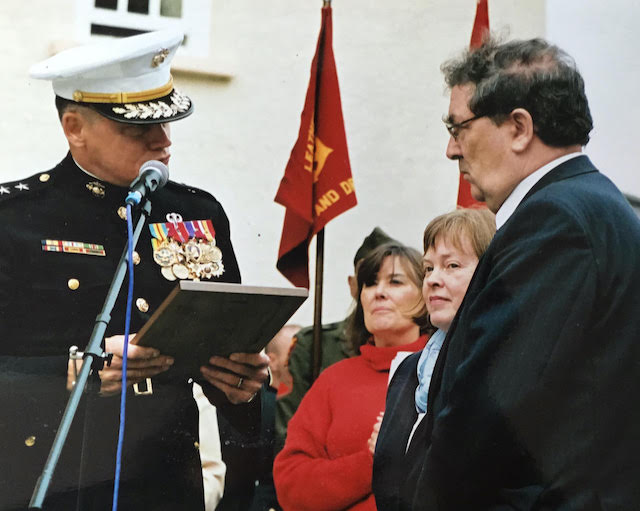
My bosses weren’t. Moderation did not make good television. We were at the beginning of the “if it bleeds it leads era.”
But I had my own segment on the show called Face-Off, a daily debate where two opposing partisans could go at each other. And, yes, I could book John Hume for that.
“I’ll make the questions generic,” I told Ted. “He can just state his opinions and ignore his opponent.“
But Mr. Hume was not interested.
“You are the only politician I’ve encountered who puts principles first,” I said to John Hume that night. Ted had taken us to dinner at Cantina, a popular Mexican restaurant on the Upper West Side. My Mom was visiting from Chicago and came along.
John began to lay out the ideas that would ultimately bring peace not just to Northern Ireland but, as he said, “Take the gun out of Irish politics for the first time in 800 years.”
All conflict is about difference
Yet the difference is the essence of humanity – an accident of birth. Respect for difference must be the basis for a just and productive society.
I didn’t take it all in or understand it completely. But one thing was very clear. As a commentator said during the funeral, John Hume was good company. Not that he was a charmer and certainly not a back slapper but he was so alive. His brain whirred right in front of you spitting out a nuanced historical analysis or the lyrics of a song. That night he sang, Don’t Cry For Me, Argentina earning us a free round of Margaritas. Evita had not been produced yet but the album was out and Don’t Cry For Me, Argentina was #1 on the UK hit parade.
“And as for fortune and as for fame/ I never invited them in.” John sang.
“They are illusions/They are not the solutions they promised to be/The answer was here all the time/I love you and hope you love me.”
Prescient. Fame and fortune would never be important to John Hume. He would become the only person in history to be awarded all three peace prizes – the Nobel, Martin Luther King, and Gandhi. Large sums were connected to these awards. He donated the money to charity – half to the Saint Vincent de Paul Society and half to the Salvation Army to serve the needs of both communities. “I don’t see these as personal recognition but as gestures of support to all the people of Northern Ireland,” he would say.
For John Hume, the answer was always in the people. He loved them and they would love him. Though I don’t think he would have put it so sentimentally. Still The Town I Loved So Well was his party piece.
He did not have to become involved in other people’s problems. Both he and his wife, Pat, had succeeded against the odds. As part of the first generation of Catholics in Northern Ireland to benefit from free university education, they became teachers and could lead a comfortable life with intellectual satisfactions. John won a trip to Paris as a French teacher and his Master’s thesis formed the basis of Leon Uris’ research for Trinity. Pat was revered by her pupils. They had started a family.
But, as Michelle Obama wrote about Barack Obama, “It was one thing to get yourself out of a stuck place. It was another thing entirely to get the place unstuck.” She came to this realization as Barack Obama spoke to women in the basement of a church, part of a consortium of Catholic parishes that hired him to come to Chicago as a community organizer to implement Catholic social justice teachings on the city’s impoverished South Side
Decades before it was a Catholic Social Action Retreat that had inspired the Humes to “unstick their place.” Establishing a Credit Union seemed a direct way to help those kept poor by an unjust system that denied them jobs, housing and even the right to vote.
John had seen his mother and aunts borrowing from moneylenders at outrageous rates of interest. He would always say that establishing the Derry Credit Union and becoming President of the Irish League of Credit Unions at age 27 was his proudest achievement.
During her funeral commentary, Mary McAleese told how as a 13-year-old she heard John tell a gathering in her Ardoyne Parish Hall that by putting together their pennies and ha pennies’ they could achieve real power. “A light bulb went off,” she said.
I left Good Morning, America for Saturday Night Live and was in a Ph.D. program focusing on Irish Studies.
I was delighted when in June 1979 John Hume was elected to the European Parliament.
That fall I went to Ireland with my Dad for three weeks and then settled in to research my dissertation –The Sovereign Woman: Her Image in the Literature of Ireland. In the Royal Irish Academy, I examined the 14th-century manuscript Book of the O’Kelly and discovered the Banshenchas, a description of prominent Irish women down through the centuries. Here were the Brehon poets and judges of ancient Ireland; the abbesses and queens. History and myths mingled together, enriching each other.
Was Queen Maeve a real person? Well, she came from somewhere.
Grace O’Malley, the Pirate Queen, definitely existed. I met one of her descendants who was modest about her spectacular ancestor. “If you are brave in a boat, they make up great stories about you.”
During that trip, I got to spend time with Pat Hume – happy the person who can write those words! I won’t wax poetic because she wouldn’t like it, but talk about ‘brave in a boat.’ Open up the Banshenchas and let her in!
In 1984 I managed to get an assignment from Rolling Stone Magazine to cover President Reagan’s visit to Ireland and John’s campaign for reelection to the European Parliament. I arrived in Derry in time to join the women of the SDLP Bogside Branch on a Sunday afternoon canvass. Margaret Doherty, her sister Anna, Kathleen Gallagher, Berna McIver, Teesie and Joanna clicking up those cobblestone streets in their high heels with Pat Hume keeping everyone’s spirits up. They knocked on door after door, bantering with those who opposed them. But these were the days of “armored cars and bombed-out bars” and that night the SDLP Headquarters was firebombed. This non-violent party faced attacks from both unionist and republican extremists. Mo Hume, Pat and John’s young daughter, then 10 years old, and I had to dodge a barrage of stone while walking through the Creggan.
“Aren’t you very afraid to live in New York?” she asked me.
Rolling Stone didn’t want the finished article. Moderation doesn’t sell magazines.
But my friends from Chicago days, Peter and Margaret O’Brien Steinfels ran the piece in Commonweal.
I took the article to WTTW – the PBS Station in Chicago. Would they be interested in collaborating on a documentary that showed a different view of Northern Ireland?
The station manager interrupted me, “It’s not news to say that a million people did not riot last night,” he said.
“It is if you assume they are going to be rioting,” I answered. “If I make the film myself, will you look at it and consider broadcasting it?”
“Okay,” he said.
I began my research by attending the SDLP Convention in November 1984. John Hume, had now been elected to both the British and European parliaments. He had orchestrated a year of meetings in Dublin called The New Ireland Forum which had produced a consensus among the nationalist parties.
Three possible models of an inclusive government in Northern Ireland were presented to Margaret Thatcher. She replied with what became known as the “Out Out Out Speech.” Depressing. I didn’t know what to expect when John Hume stood up to speak to his party members. He didn’t say a word but began singing “I wandered today through the hills, Maggie.” Everybody laughed and by the end, they all sang together, “But to me, you’re as fair as you were, Maggie, when you and I were young.”
These people will not be defeated I thought.
I had a cameraman friend, frequent flyer miles, and some cash from writing screenplays in Hollywood and set out to cover the May 1985 local elections which would test SDLP support. Sinn Féin was contesting the elections for the first time. Commentators were predicting the extremists would win. But the election results were good news for the SDLP. They took an overwhelming number of seats on the Derry City Council.
Afterward, I was able to spend time in John’s constituency office where Pat Hume kept an open-door policy, solving problems that ranged from an emergency coal delivery for a senior citizen to monitoring the arrest of an unjustly accused young man. Lunch times were my favorite. John Tierney, Lord Mayor of Derry, John Hume’s young research assistant, Mark Durkan, and Pat’s assistant Jackie Green were the regulars. Often John’s sister, Agnes, Councillor Jim Clifford, and Stan, an older man who had served in the British Army, would gather for conversation and sandwiches. The craic was always great!
The hardest part of filming the documentary was getting John Hume to sit down for an interview. He wasn’t available during the election campaign. Finally, I managed an hour with him in New York City. And he gave me the title of the film, “To Live For Ireland”
“For too long Irish patriotism meant dying for Ireland. I want our young people to live for Ireland! To shed their sweat, not their blood,” John said.
That was his message to Irish America. Don’t romanticize martyrdom. Don’t glorify violence. Help us create a New Ireland.
PBS Broadcast “To Live For Ireland”. Good reviews. Awards. Though a newspaper reporter friend said to me, “I don’t know, Mary Pat, you’ve got a lot of little kids in there and no political scientists.”
But it was the children that made my mother cry. How can anyone put those lives at risk? she wondered. When I ran out of money she gave me the funds to finish the documentary. I made her the Executive Producer.
But one thing was annoying. At screenings, someone would see shots of the Sperrin Mountains, the beach at Downhill, or the River Foyle and say, “But that can’t be Northern Ireland!” It was as if a cloak of invisibility smothered this part of the island of Ireland turning it into a desolate wasteland of media images. A place of bombs and bullets and people steeped in bigotry.
By this time Irish America magazine had been founded. Editor, Patricia Harty, assigned me the interview with Ian Henderson, the head of the Northern Ireland Tourist Board when he came to New York City. I discovered he was a military historian specializing in the American presence in Northern Ireland during WWII.
What??
YES – 300,000 American servicemen were stationed in Northern Ireland.
Here was a great, largely unknown, story that would interest all Americans. And it was 1991, the beginning of the 50th anniversary of WWII. Northern Ireland – away from the troubles; the people the scenery; the hospitality. “Home Away From Home: The Yanks in Ireland” premiered on PBS.
Phil Coulter wrote the theme song which has become a worldwide hit.
Derry was Base One Europe, the site of the largest U.S. Navy base in Europe. Five hundred Marines guarded the base. They were billeted on the grounds of the Beech Hill estate in the village of Ardmore, just outside the city. Now as Beech Hill Country House Hotel, it was John Hume’s go-to place for the politicians and business people who were coming to Derry to help transform the city and Northern Ireland. Teddy Kennedy had his own room in the hotel.
Then in 1997, the Marines started arriving, happy to reconnect with this part of their heritage. Patsy O’Kane, the owner of Beech Hill, hosted an annual event with as many as 100 Marines in attendance and a good turnout of local people. Each year the Paddy Hone Award, named for Pat Hume’s father, a revered resident of Ardmore, was presented. John Hume delighted in these occasions.
Here was a chance for John to reconnect with a formative part of his childhood. As a six-year-old during the war years, he learned to play baseball from the Marines. Tipped them off as to which dog would win at the illegal greyhound track (“I‘d watch to see which dog would get a jag from Dr. Iodine.”) and enjoyed the sweets that rationing had taken away. But more importantly, he remembered a group of people for whom religion was not the badge of difference who hired Catholic men to work on the base and gave both his father and Pat’s father the best job of their lives.
I’d like to imagine that a Marine gave young John a penny and explained “E Pluribus Unum – From Many We Are One.” John Hume would often say this was the concept upon which he based his philosophy for peace.
Lt. Gen. Martin Berndt, and Sgt. Maj. of the Marine Corps Carlton Kent made a number of trips to Derry and formed a friendship with John.

“No one wants peace more than a soldier who has been in battle,” Martin Berndt told John. And Sgt. Maj. Kent appreciated the connections between the US Civil Rights Movement and the one that John led in Northern Ireland.
“As soon as I met John I knew he was the type of person with great character and a servant leader. He spoke with us about the importance of acceptance and diversity and about the positive impact the Marines had on him when he lived near the camp and enjoyed his time with the Marines as a child,” Carlton Kent recalled.
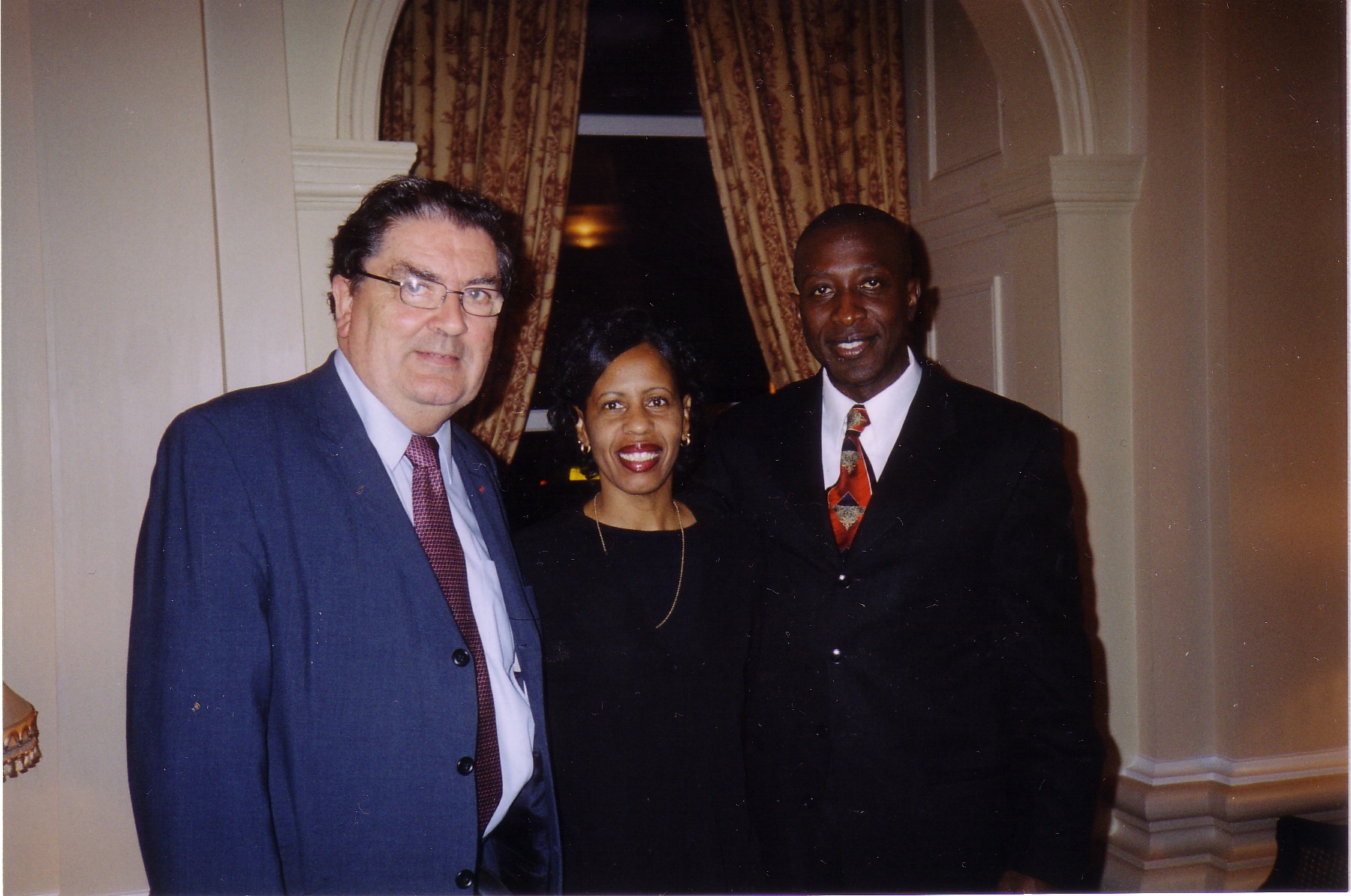
It’s October 1998. The Good Friday Agreement is in effect. Peace is already changing people’s lives. My mom, her best friend since childhood, Nancy, and I are visiting Derry. John and Pat take us out to dinner on what will turn out to be the night before the recipients of the Nobel Peace Prize are announced. As we drive to the restaurant in Donegal, Pat points out the place where Hugh O’Neill and Rory O’Donnell sailed from Ireland in the Flight of the Earls.
The winner really is a secret. No one knows. And no one wants to speak about what possibly could be. We’re all tense.
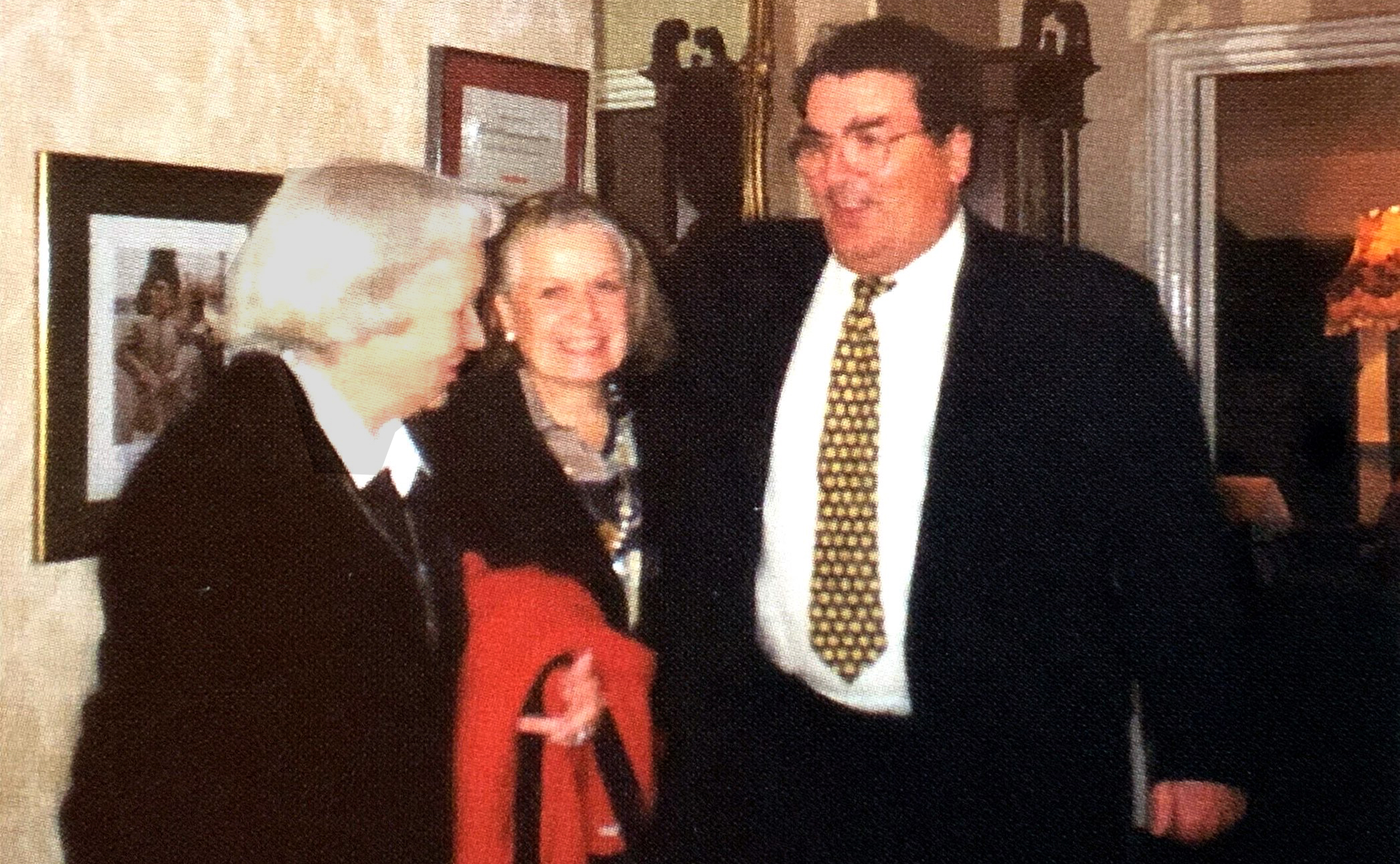
Then my mother’s friend Nancy raises her glass. “Here’s to you know what.” We laugh. Start talking. John sings “Danny Boy.” The next morning Pat will see a “V” of wild geese in the sky. The announcement comes John Hume and David Trimble win the 1998 Nobel Peace Prize.
My County Tyrone husband, Martin Sheerin, and I watched John‘s funeral broadcast with my mother who is now 99. That beautiful ceremony, so full of the spirit of Pat Hume.
I remembered filming “To Live For Ireland” and 11-year-old Anthony Carlin who helped around the office went canvassing, and handed out election literature.
“Why do you support the SDLP?” I asked him. I suppose I expected something about bringing peace. Instead, he said, “Well they’re kind. They take you around places. They’re a good laugh.”
Yes.
Goodbye, John. Thank you!

Read Mary Pat Kelly’s piece on Pat Hume, Remembering Pat Hume or return to the John Hume tribute page.
Mary Pat Kelly’s celebrated historical fiction series, the bestseller Galway Bay, Of Irish Blood and now Irish Above All tells the Irish American story through her own family’s saga. https://marypatkelly.

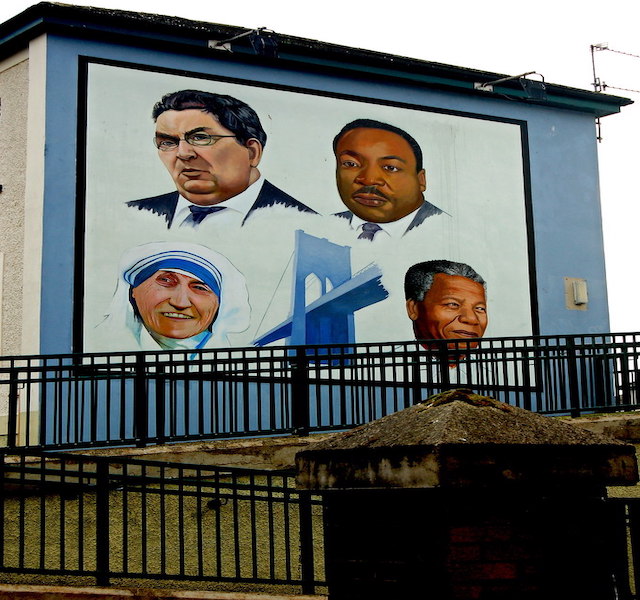
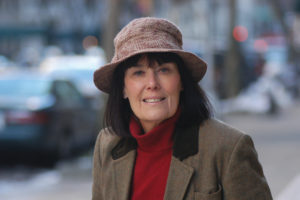
Beautiful article. Mary Pat brings her rich history with John and Pat Hume to life. Thank you.
Mary Pat,
I hope this wonderful recollection of your friendship with John becomes a book.
You were on that journey all along.
So glad we did get to honor Pat and John at the UN in NYC. And our timing was great. It had just been announced that he was awarded the Nobel Peace Prize. I still have is amazing speech from that night. Stay well. Keep writing.
Brilliant as always Mary Pat. Is there a way we can share this article on facebook so the Irish hour radio listeners can read it? Thanks so much. Love, Mary Terese
Mary Pat. Thanks for such an engaging story. Love to you and your mom..
Great appreciation piece on John and Pat Hume. You’ve captured their dynamic energy in the cause of peace and their authentic love and respect for all people. As some one who also canvassed for John a Westminster election, I had the same experience of Pat’s wonderful calm and support for the canvasing team, and the great pick up lunches in John’s constitutency office. Their legacy to Ireland and the world is great and still inspires.